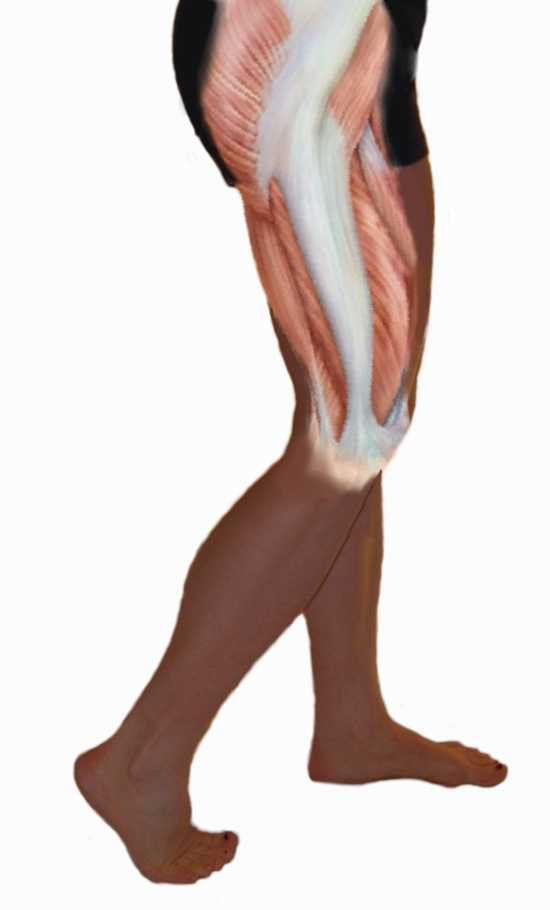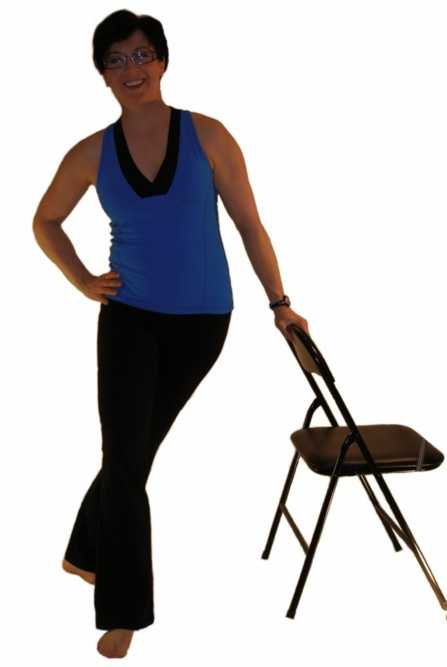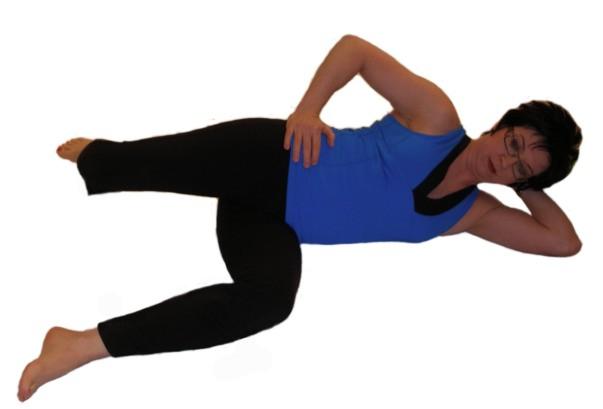Iliotibial Band
Stretching the iliotibial band (IT band) is something that people rarely think of unless they are involved in sports of some sort. Because it is not a muscle, it doesn't occur to people that it would need to be stretched. The IT band provides attachment for the gluteus maximus and tensor fascia lata for hip abduction and provides stability to the knee. In the closed kinetic chain the action on the IT band controls the movement of the leg toward midline (adduction) and lateral tilting of the pelvis. This stability is needed in running and walking.
Contents
What
is
the IT band?
How does
the IT band move?
What
is snapping hip?
What
is trochanteric bursitis?
What
is iliotibial band syndrome?
ITB Syndrome
and Muscular Imbalances
How is IT band
syndrome and trochanteric bursitis treated.
How can I
prevent IT band problems?
Iliotibial band stretches
What is the Iliotibial Band?

The IT band is a thick band of fascia that lies over the outside of the thigh. The deep fascia of the thigh is known as the fascia lata. It is strong and dense and invests the muscles of the thigh like a stocking. it is thickened along a band from the iliac crest to the tibia and it is this part that is referred to as the iliotibial band. The muscles tensor fascia lata and gluteus maximus insert into the IT band and the IT band is continuous with the lateral intermuscular septum deep to it.
How does the iliotibial band move?
The iliotibial band moves forward and backward relative to the axis of
rotation of the knee and is thus prone to friction over the lateral
epicondyle on the outer aspect of the knee. There is a bursa that lies
between the ITB and the epicondyle which often becomes inflamed in
these friction syndromes.
The iliotibial band also moves over the greater trochanter of the femur
as one walks or runs. That is what you feel is the "hip bone" on the
side of your pelvis. It is here that it is also prone to friction. The
large trochanteric bursa is a cushion that lies between the iliotibial
band and the greater trochanter. This becomes inflamed when the
iliotibial band is tight. This is sometimes referred to as "snapping
hip syndrome" or "iliotibial band syndrome".
Snapping Hip Syndrome
Pain and tenderness are apparent over the hip or the outside of the
knee or both. A snapping may be felt during walking or stair climbing.
Tightness
in the IT band is usually the cause, but in some
athletes it may be due to tightness in the hip muscles, pulling the IT
band tight. Excessive use of the hip abductors and external
rotators can result in muscle imbalances causing ITB tightness.
Lengthening the ITB and correcting poor movement patterns and muscle
imbalances is the best method of treating ITB tightness issues.
* deep friction massage
* stretching
* ice to address any inflammation
To prevent these issues it is important to incorporate a stretching
routine into your training program that addresses hip musculature and
ITB.
Trochanteric Bursitis
A bursa is a sack of fluid found between moving parts of the body.
There
is a large bursa over the lateral aspect of your hip that is normally
asymptomatic and functions to allow the iliotibial band to glide
smoothly over the greater trochanter. Through acute trauma, cumulative
trauma, or repeated irritation from friction, the bursa can become
inflamed. Often stretching is included in treatment to address the
causes of trochanteric bursitis If you suspect you are suffering from
pain related to trochanteric bursitis it is important to see your
physical therapist for a full evaluation.
Simply stretching may not be enough and the sooner you address
problems, often the easier they are to fix.
Possible causes of trochanteric bursitis are as follows:
- Direct trauma due to a fall, sleeping on a hard surface, surgery, or hit playing sports
- Repeated excess friction of the ITB against the greater trochanter due to:
- Muscle imbalances
- Gait problems
- Leg length discrepancy
- No apparent reason
What is IT band syndrome?
IT band syndrome is one of the most common problems
amongst
runners. Repetitive knee flexion will create excessive friction of the
iliotibial band on the femur which can be exacerbated by running on the
same side of the road or always running the same direction around the
track.
Other biomechanical problems can lead to IT band issues such as
- Over pronation of the foot while walking or running. This overpronation causes excessive rotation of the tibia, which in turn causes excessive rotation of the femur.
- Leg length discrepancy. A leg length discrepancy causes a tilting of the pelvis forcing the IT band to stretch over the prominences of the higher hip.
- Muscle tightness in the gluteal muscles will pull the ITB tight.
Treatment of iliotibial band syndrome and trochanteric bursitis.
Problems to be addressed with this disorder are as follows:
- Inflammation Ice, antiinflammatories, and ultrasound may be used by your physical therapist. Relative rest is also advised until inflammation is under control. Persistent inflammation results in the deposition of scar tissue, worsening the friction and tightness.
- ITB tightness ITB stretches at home and those assisted by your physical therapist. See the list on this page.
- Muscle imbalances Overuse of some muscles, and tightening of others can result from specific sports training or just a sedentary lifestyle and must be addressed to prevent recurrences.
- Gait disorders can be corrected through the use of orthotics, or if there is any other underlying joint dysfunction, this will be addressed through manual treatment by your physical therapist.
- Poor movement patterns can cause excessive pelvic motion resulting in stress on the ITB. Gait training and feedback can assist you in correcting this if this is an issue.
To get to the bottom of the source of your iliotibial band syndrome it
is prudent to be evaluated by a physical therapist. From my experience
trochanteric bursitis responds well to physical therapy when
all
biomechanical causes are addressed. Simply treating the
symptoms is often not enough
How can I prevent iliotibial band problems?
Here are some tips to prevent iliotibial band syndrome:
- If you are a runner make sure you are fitted with the appropriate shoes or wear your othotics if those have been prescribed.
- Replace your shoes in a timely fashion. The standard is every 300-500 miles, but depending on your wear pattern that may be different for you.
- Avoid running too many hills or stairs.
- If running on the street, switch sides of the street regularly.
- If running on a track, change directions regularly.
- Thoroughly stretch before running.
- Avoid crossing your legs while sitting.
- use your foam roller on a regular basis.
- When running, don't increase your mileage too quickly.
- Above all, if it hurts don't run through it. Have it evaluated by a physical therapist.
Iliotibial Band Stretches
Using an Exercise Ball
Using an exercise ball you can stretch the IT band as follows:
- To stretch your right iliotibial band lean your right hip against an exercise ball.
- Cross the left leg in front of the right.
- Allow the right leg to move out away from the exercise ball while keeping your chest up.
- Lean further into the ball as you left your chest up and pull your head to the ceiling.
- Breath out as you gently rock the pelvis back and forth and sink into the exercise ball.
Hold this for the appropriate
time.

In
Standing
To stretch the right IT band in standing, stand with your right side
facing a wall
or leaning on the back of a chair.
- Put your right foot behind your left foot and point the toes of your right foot out about 45 degrees.
- Put your left hand on your left hip and while keeping your right leg straight, push your hip in toward the wall.
- A common mistake made when performing this stretch is to bend forward at the hips or to rotate the body.
- Make sure you remain upright and keep your torso perpendicular to the wall.
Hold this position for the appropriate time.

Another method of stretching the ITB
in standing
is to stand facing a chair or counter top.
- Put your right foot behind you and to the left of your left foot as far as you can while remaining tall.
- Without bending forward, lower yourself until you feel tension in the outside of your right thigh.
- Relax and exhale, holding this stretch for the appropriate time.

In
Lying
- To stretch the right it band lie on your left side with your left hip and knee flexed to 90 degrees.
- Put your right hand on your right hip to stabilize your pelvis.
- Bend your right knee to 90 degrees as your right hip stays straight.
- Allow gravity to pull your right knee toward the floor.
- Be sure to keep your pelvis stable with your right hand.
- Relax and hold this for the appropriate time.

In Sitting
- To do this stretch you must be able to comfortably sit on the floor and already have good hip mobility. Sit with your legs crossed, right leg on top .
- Slide the top leg across so that your knees are touching or try and get them as close as you can.
- Bring your feet forward in front of your knees. (If you feel any strain in your knees or pain in your groin then stop the stretch and straighten your knees. You may have an underlying hip or knee problem and should seek the advice of a physical therapist.)
- Keep your back straight and bend your trunk toward the right foot.
Hold this position for the appropriate time, relax and breath.
Using
a Foam Roll
Using the foam roller helps to release adhesions, relax the muscles,
stimulate the circulation and gently stretch the ITB and surrounding
musculature.
- Lie on the right side with the foam roller beneath the thigh toward the top of your thigh.
- Place your left foot in front of you for balance and support. Roll yourself slowly along the foam roller toward the knee but don't go beyond the knee.
- Be sure to move slowly and breath throughout.
- Do not apply so much pressure that it is painful, and if you get to a tense area you can hold it for 20 to 30 seconds extra at those points.
Using
the Stick
Using the stick to loosen up the fascia on the lateral aspect of the
thigh is most easily done by a partner.
- Lie on your left side with left hip and knee slightly bent.
- Grab hold of your right ankle behind you with your right hand.
- Allow gravity to pull your knee down toward the floor.
- Have your partner use the stick up and down on your vastus lateralis and iliotibial band for 20 to 30 strokes as tolerated.
Iliotibial Band Syndrome and Muscular Imbalances
If you suffer from iliotibial band syndrome it may be because of
underlying weaknesses in your core and/or hip musculature. Stretches
are necessary, but you should also be evaluated by a physical therapist
to determine if there is an underlying imbalance.
A study published in the Clinical Journal of Sports Medicine looked at
24 randomly selected long distance runners with IT band
syndrome
compared to 30 asymptomatic long distance runners.(1) It was
found that those with ITBS had statistically significantly weaker hip
abductor strength on the affected side when compared to the unaffected
side and those of the uninjured runners. They also found that after a 6
week program of strengthening 22 of the 24 athletes were painfree and
there was no report of recurrences 6 months later.
A prospective study of the biomechanical forces on the IT band in
individuals with iliotibial band syndrome found that those suffering
from the disorder exhibited abnormal hip and knee motion.(2)
Excessive hip adduction and knee internal rotation during running and
bicycling causes compression of the IT band against the lateral femoral
condyle of the knee. This group of researchers also recommend treatment
that includes controlling these movements through stretching,
strengthening, and reeducation.
1. M
Fredericson MD, CL Cookingham
MS, PT, AM Chaudhari MS, BC Dowdell MD, N Oestreicher BS, SA Sahrmann
PhD, PT. Hip Abductor Weakness in Distance Runners with Iliotibial Band
Syndrome. Clinical Journal of Sport Medicine: July 2000 - Volume 10 -
Issue 3 - pp 169-175
2. B Noehrena, I Davisa, J Hamill. Prospective study
of the
biomechanical factors associated with iliotibial band syndrome.
Clinical Biomechanics Volume 22, Issue 9, November 2007, Pages 951-956 .